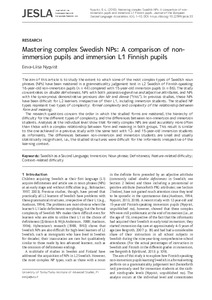Mastering complex Swedish NPs: A comparison of non-immersion pupils and immersion L1 Finnish pupils
Eeva-Liisa Nyqvist
https://urn.fi/URN:NBN:fi-fe2021042719280
Tiivistelmä
The aim of this article is to study the extent to which some of the most complex types of Swedish noun phrases (NPs) have been mastered in a grammaticality judgement test in L2 Swedish of Finnish-speaking 16-year-old non-immersion pupils (n = 44) compared with 15-year-old immersion pupils (n = 86). The study concentrates on double definiteness, NPs with both possessive/genitive and adjective attributes, and NPs with the synonymous demonstrative pronouns den här and denna (“this”). In previous studies, these NPs have been difficult for L2 learners irrespective of their L1, including immersion students. The studied NP types represent two types of complexity: formal complexity and complexity of the relationship between form and meaning.
The research questions concern the order in which the studied forms are mastered, the hierarchy of difficulty for the different types of complexity, and the differences between non-immersion and immersion students. Analyses at the individual level show that formally complex NPs are used accurately more often than those with a complex relationship between form and meaning in both groups. This result is similar to the one achieved in a previous study with the same test with 12- and 15-year-old immersion students as informants. The differences between non-immersion and immersion students are small and usually statistically insignificant, i.e., the studied structures were difficult for the informants irrespective of the learning context.
Kokoelmat
- Rinnakkaistallenteet [27094]
